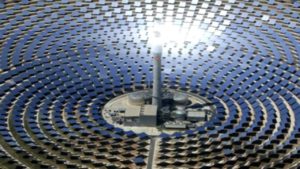Scientists using satellite technologies have discovered for the first time that large scale solar parks have a cooling effect on the land surrounding them.
 As more countries pledge to achieve net zero carbon emissions there will be a greater reliance on renewable energy sources, such as wind turbines and solar energy. However, there is very little evidence on the impacts large-scale solar farms have on the local environment. It is therefore really important to understand climate impacts as this affects the ecological responses.
As more countries pledge to achieve net zero carbon emissions there will be a greater reliance on renewable energy sources, such as wind turbines and solar energy. However, there is very little evidence on the impacts large-scale solar farms have on the local environment. It is therefore really important to understand climate impacts as this affects the ecological responses.
The team of scientists, from Lancaster University, Ludong University in China, and the University of California Davis in the USA focused on two large-scale solar parks located in arid locations – the 300 MW Stateline solar park in California USA, and the 850 MW Longyangxia solar park in China.
The researchers used land surface temperature data derived from Landsat satellite images, an approach not previously applied to solar parks. This enabled the study team to compare the land surface temperatures around solar parks before and after the solar parks were constructed. The satellite data was supplemented by on the ground temperature measurements around Stateline solar park.
They found that the parks produced ‘cool islands’ extending around 700 metres from the solar park boundaries. The temperature of surrounding land surface was reduced by up to 2.3 ℃ at 100 metres away from the solar park, with the cooling effects reducing exponentially to 700 metres.
This new discovery is important as it shows the solar park could impact ecological processes, including productivity, decomposition, and ultimately the carbon balance, in the surrounding landscape. The scale of effect will depend on the location and could be positive, negative or inconsequential.
For example, previous studies have shown that lower surface temperatures on the Tibetan Plateau could potentially reduce the amount of methane lost to the atmosphere. However, in the Mojave Desert, lower temperatures resulted in fewer seeds germinating, which may mean fewer plants surviving to adulthood, reducing biodiversity.
The new findings therefore highlight the need for greater consideration to be given to where solar parks are built around the world, as well as their design, to minimise any negative impacts and boost positive effects.
Dr Alona Armstrong, co-lead author from Lancaster University, said: “Most studies examine the impacts of land use change for solar parks inside the site boundaries. Here, we found a temperature effect that is evident up to around 700 metres away, suggesting that ecological processes may also be impacted.
“This heightens the importance of understanding the implications of renewable energy technologies on the hosting landscape – we need to ensure that the energy transition does not cause undue damage to ecological systems and ideally has net positive consequences on the places where we build them.”
Although further studies are needed to determine the exact mechanisms that cause the cool island effect and how it might vary with location and solar park design, the researchers hypothesise it is due to the solar arrays shading and insulating the land surface, as well as energy being converted into electricity by the solar panels.
###
The findings are outlined in the paper ‘Ground-mounted photovoltaic solar parks promote land surface cool islands in arid ecosystems’ published by the journal Renewable and Sustainable Energy Transition.
As the study was focused on two solar parks in arid locations, further studies are required to determine if cool islands are caused by solar parks in more temperate locations.
The paper’s authors are: Li Guoqing of Ludong University; Rebecca R. Hernandez of the University California Davis; Alan Blackburn, Gemma Davies, Merryn Hunt, Duncan Whyatt, and Alona Armstrong of Lancaster University.
Source: LANCASTER UNIVERSITY